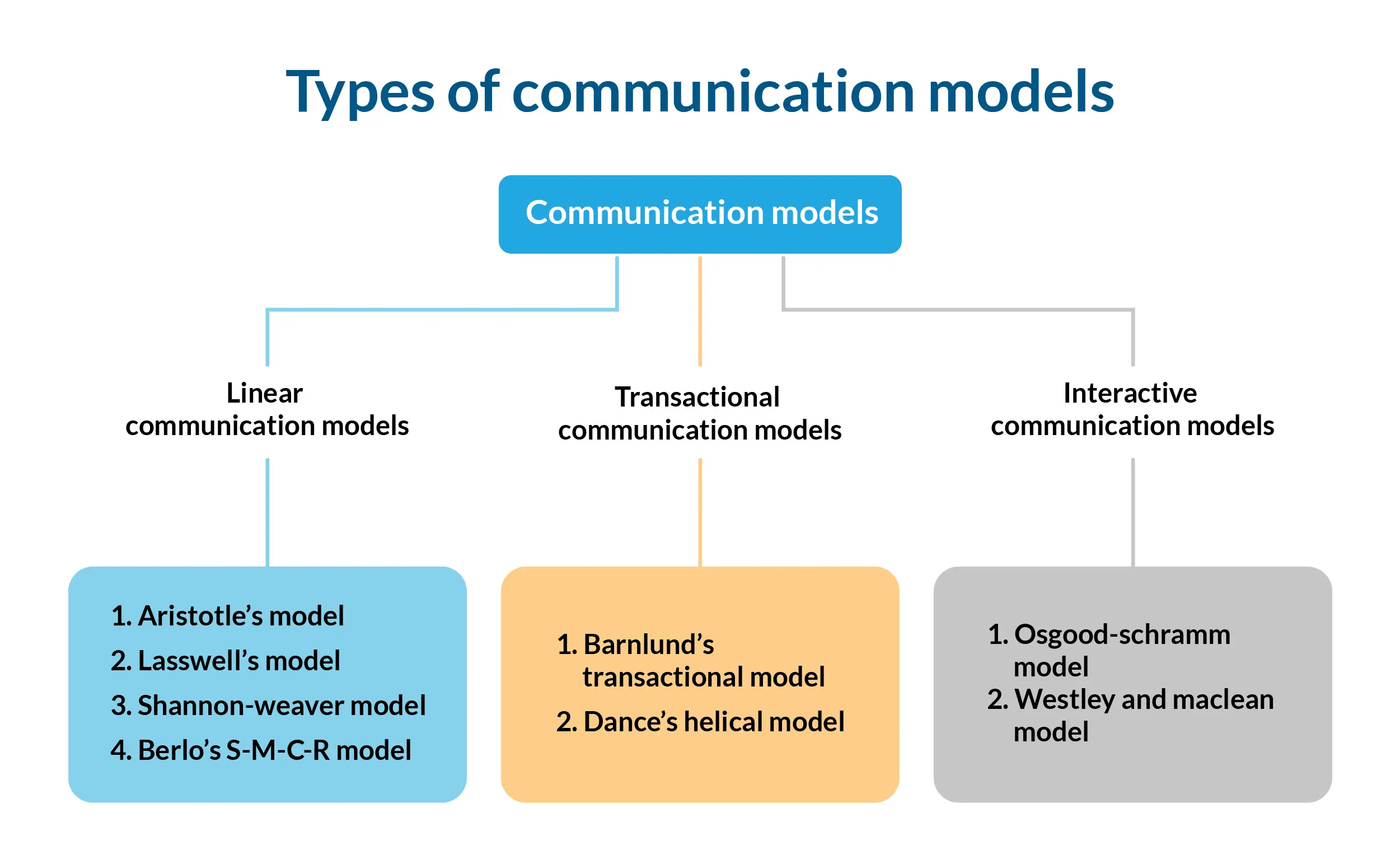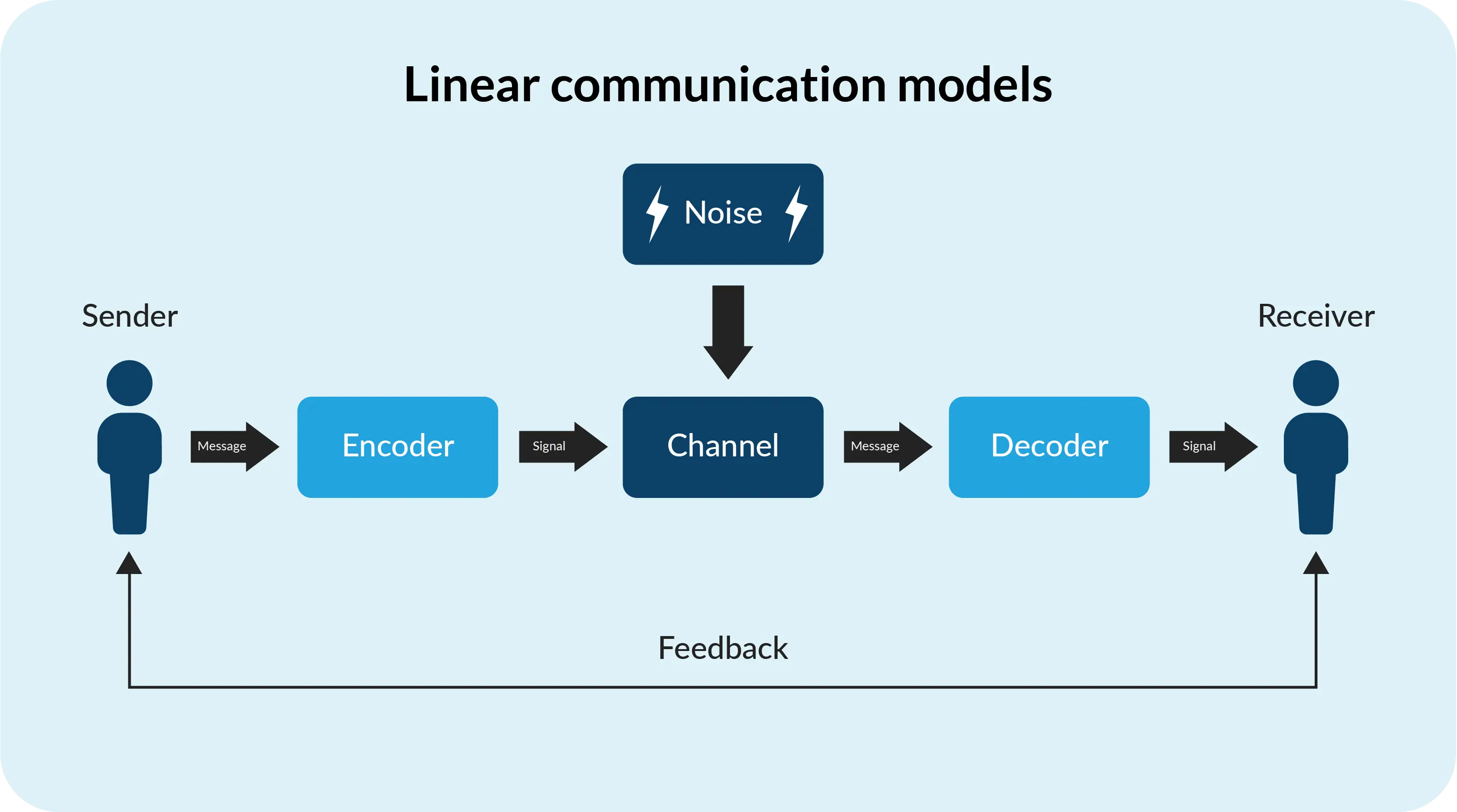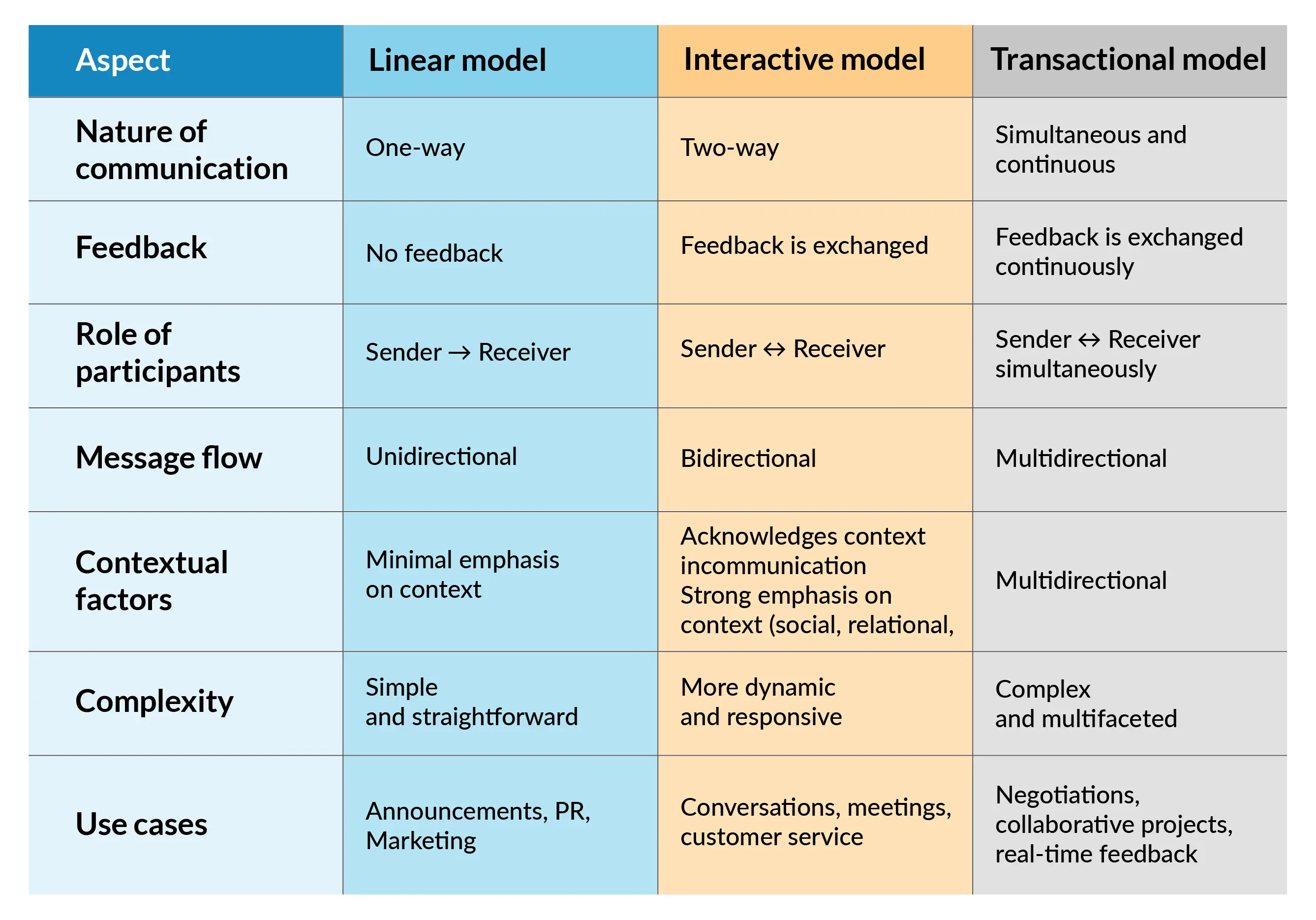8 Communication models: Understanding models of communication for better business interactions.

Effective communication is the backbone of any successful business operation. It is essential to understand the various models that have been developed over time to master the art of communication. These models help us understand how messages are delivered, received, and interpreted.
This guide will walk you through the eight primary communication models, focusing on their application in business.
Why is understanding types of communication models important in business?
Understanding communication models is essential to effective communication in any business context. Communication models are essential for improving business interactions as they provide structured frameworks that help understand and enhance how information is exchanged. Following are a few benefits of communication models that help us in everyday work life:
- Simplifying complex processes: Communication models break down the process of communication into easy and understandable parts, making it easier to analyze how information is exchanged between parties.
- Identifying roles: Models clarify the roles of the sender, receiver, and medium. This allows us to see how each contributes to the effective interactions.
- Highlighting barriers: They help us to identify potential obstacles, like noise or misunderstandings, that can disrupt communication. This also enables us to address and mitigate the challenges.
- Providing frameworks for improvement: Understanding different communication models helps us identify areas for improvement in our interactions.
- Adapting to different scenarios: Different models apply to various communication contexts, such as public speaking, team collaboration, or customer interactions. They guide us in choosing the best approach for each situation.
- Enhancing decision-making: Understanding how communication flows and where it might break down helps leaders make more informed decisions. This also ensures that key messages are delivered and understood as intended.
The 8 models of communication:
There are three primary communication models, each with its own respective set of theories that have evolved over time. These eight models provide a structured approach to analyzing and improving communication, helping professionals apply the right strategy depending on the situation. Each model has its strengths, and when applied in the right situation, it can enhance business interaction.

Linear model- This model describes communication as a one-way process.
- Aristotle’s Model
- Lasswell’s Model
- Shannon-Weaver Model
- Berlo’s S-M-C-R Model
Interactive model- This model views communication as a two-way exchange.
- Schramm’s model of communication
- Osgood-Schramm model
Transactional model- This model recognizes that communication becomes more complex as conversations evolve.
- Barnlund’s transactional model
- Helical model of communication
Overview of the linear model of communication:
The linear model of communication represents a one-way communication process. Here, the sender's primary goal is to deliver a message clearly and directly, with a specific objective in mind. The sender does not anticipate an immediate response from the receiver. This model also considers the factor of noise, which can affect and distort the message.
Application in business: This model is primarily used in PR content, marketing, and sales campaigns, where the goal is just to broadcast a message to a wide audience without expecting immediate feedback.
The linear communication process and its impact:
The linear communication process involves three key elements: the sender, the channel, and the receiver. The sender sends the message through a chosen channel which can be a newspaper, television, radio, or digital platform. Depending on the channel, the message can be conveyed through speech, writing, or visuals. The receiver then decodes the message.
This model is highly effective for quickly and efficiently disseminating information to large audiences. However, it lacks the feedback loop, which is a necessary part of a two-way interaction.

Types of Linear Communication Models
Linear models offer a straightforward view of how messages are transmitted from a sender to a receiver. There are four main linear communication models, each with unique characteristics and practical business applications:
1. Aristotle’s model of communication
Aristotle’s model is one of the earliest communication models. In it, Aristotle emphasizes the importance of the speaker in crafting a persuasive message. The focus is on how the speaker can influence the audience by carefully constructing the message with a clear purpose in mind.
Example:
Imagine a CEO delivering a keynote speech to potential investors. The CEO’s goal is to persuade the audience to invest in the company. Using Aristotle’s model, the CEO would carefully structure the speech, focusing on clear arguments, supporting evidence, and an emotional appeal to convince the audience of the company’s potential.
This model is especially useful when the primary goal is to persuade, such as during public speaking, sales presentations, or pitches to stakeholders.
2. Lasswell’s model of communication
Lasswell’s model breaks down communication into five key components: who (the communicator), says what (the message), in which channel (the medium), to whom (the audience), and with what effect (the outcome). This model is particularly valuable for analyzing the effectiveness of communication strategies.
Example:
Consider a company launching a new product through an advertising campaign. The marketing team uses Lasswell’s model to design the campaign:
- Who: The company (communicator)
- Says what: The benefits of the new product (message)
- In which channel: Through social media and TV ads (medium)
- To whom: Target customers (audience)
- With what effect: To increase sales and brand awareness (outcome)
Lasswell’s model is ideal for developing and evaluating marketing and advertising strategies. It ensures that each element of the communication process is effectively aligned to achieve the desired result.
3. The Shannon and Weaver model of communication
This model was initially developed to improve telephone communication. The Shannon-Weaver model introduces the concept of “noise,” which can interfere with the clarity of the message. The model emphasizes the need to minimize noise and ensure that the message is clearly transmitted and accurately received.
Example:
Imagine a manager sending an important email to a team. If the email contains jargon or unclear instructions, it may create “noise” that may confuse the team members. To avoid this, the manager should use simple language and clear instructions, ensuring the message is understood.
The Shannon-Weaver model is crucial for any form of business communication where clarity is key, such as in emails, reports, or presentations. By identifying and reducing potential sources of noise, businesses can improve the effectiveness of their communication.
4. Berlo’s S-M-C-R model of communication
Berlo’s model breaks down communication into four components: source (the sender), message, channel (the medium), and receiver. It highlights how the personal characteristics of the sender and receiver, such as their communication skills, attitudes, knowledge, and social systems, influence the communication process.
Example:
Consider a training session in which a skilled trainer (source) delivers a technical presentation (message) via a webinar (channel) to a group of employees (receivers). The session's effectiveness depends on the trainer’s ability to convey the information clearly and the employees’ ability to understand and apply it.
Berlo’s model is helpful in training and development, customer service, and team communication, where understanding the sender's and receiver's characteristics can enhance the overall communication process.
Communication theory: Analyzing the linear communication model
The linear model is foundational in communication theory. It offers a simple yet powerful way to understand how information is transmitted from one point to another. Let's analyze this model to gain insights into its strengths, limitations, and practical applications in various business contexts.
Strengths:
One of the linear communication model’s greatest strengths is its simplicity. It is particularly effective when the primary goal is to convey a message clearly and directly without needing feedback or interaction.
Limitations:
While the linear communication model is useful in many situations, it has limitations, especially when applied to more dynamic or interactive communication scenarios.
- Lack of feedback: One of the main criticisms of this model is that it does not account for feedback from the receiver. This can lead to misunderstandings or misinterpretations, as the sender cannot know how the message was received or understood.
- Oversimplification: The model assumes that communication is a straightforward process, which may not be the case in real-world scenarios, where multiple factors, such as context, background noise, or the receiver’s state of mind, can influence its effectiveness.
- Inflexibility: The model doesn’t account for the evolving nature of communication, where messages can change or be adapted based on ongoing interactions.
Businesses can leverage the linear communication model when direct, one-way communication is most effective, such as in advertising, policy announcements, and instructional content. However, it’s important to recognize when a more interactive communication model might be necessary to ensure engagement and understanding.
Which linear model is relevant in today’s business world?
Among the four linear communication models, Lasswell’s model of communication and The Shannon-Weaver model of communication remains the most widely used and relevant in business from 2024 onwards.
Lasswell’s model of communication:
Lasswell’s model is valuable in analyzing and strategizing media and advertising campaigns. This model helps organizations craft messages that resonate with specific audiences across various channels in a digital marketing and targeted communication-dominated business landscape. It’s essential for designing effective marketing strategies, brand messaging, and communication plans that aim to influence consumer behavior.
The Shannon-Weaver model of communication:
The Shannon-Weaver model was originally developed for technical communication, but it has become crucial in any business setting where clarity and precision are vital. This model focuses on minimizing noise and ensuring the accuracy of the message, making it highly relevant in today’s fast-paced, information-heavy environment. Businesses rely on this model to improve communication efficiency, especially in operations, project management, and technology-driven communication, where reducing miscommunication can lead to better outcomes and productivity.
These models are still applicable because they address core communication aspects crucial for business success: targeting the right audience with the right message and ensuring that communication is clear and free from distortions.
Interactive model of communication: How it works
The interactive communication model builds on the linear model by adding the concept of feedback. In this model, communication is a two-way process where both the sender and receiver participate actively. Unlike the linear model, which is one-directional, the interactive model allows for a back-and-forth exchange. It also considers context, noise, and the continuous adaptation of messages based on feedback. This makes communication more dynamic and responsive, as both parties take turns sending and receiving messages.

Types of interactive communication models:
There are a few variations within the interactive model, each highlighting different aspects of communication:
1. Schramm’s model of communication:
This model emphasizes the importance of shared experience between the sender and the receiver. The message is only effective if both parties have common ground, making it easier to encode and decode the message.
Example:
A marketing team creates a campaign targeted at a specific demographic. They base their messaging on shared cultural references that resonate with the audience, ensuring the message is understood as intended.
Schramm’s communication model is particularly useful in business when crafting targeted marketing campaigns or customer communication strategies. By emphasizing the importance of shared experiences, this model helps ensure that messages resonate with the target audience. This approach is often used in branding, advertising, and customer engagement.
2. Osgood-Schramm model:
This model is also known as the circular model of communication. It adds the concept of feedback, making the communication process more cyclical. Here, the sender and receiver can switch roles as they engage in dialogue.
Example:
In a brainstorming session, team members continuously exchange ideas, with each person building on the others' input. The roles of sender and receiver alternate rapidly, fostering collaborative innovation.
In scenarios like brainstorming sessions, team meetings, or project collaborations, this model supports a dynamic exchange of ideas where participants continuously provide feedback and build on each other’s contributions. This cyclical communication process enhances innovation, problem-solving, and decision-making, making it ideal for environments that require creative thinking and teamwork.
Analyzing the interactive communication model:
The interactive communication model is beneficial when feedback, such as customer service, online discussions, and collaborative work environments are essential. By acknowledging the importance of feedback, this model provides a more realistic representation of how communication happens in real-world scenarios. However, it still has its own limitations. Let's analyze the strengths and weaknesses of this model.
Strengths: The interactive communication model excels in fostering a dynamic exchange where immediate feedback is possible. This feedback loop helps quickly address and clarify misunderstandings, ensuring the message is accurately interpreted. Moreover, encouraging active participation from both the sender and the receiver makes the communication process more engaging and collaborative, particularly beneficial in team settings and customer interactions.
Limitations: Despite its strengths, the interactive model does have limitations. It operates assuming that communication follows a linear, sequential path, making it less effective in more complex or fast-paced conversations where multiple messages might be exchanged simultaneously. Additionally, the dependency on feedback loops can slow the communication process, making it less efficient when quick, decisive communication is necessary.
Role of interactive communication model in business:
The interactive communication model plays a crucial role in fostering collaborative and responsive exchanges. With the rise of digital communication platforms, real-time interactions between teams, clients, and stakeholders have become the norm, thereby making interactive communication even more important.
- Real-time interactions: The interactive model supports immediate exchanges between teams, clients, and stakeholders, which is essential in today's fast-paced business environment.
- Instant feedback: This model facilitates quick responses to customer inquiries, helping resolve issues promptly and enhancing customer satisfaction.
- Agile decision-making: In internal communications, the interactive model allows team members to contribute ideas, ask questions, and provide feedback, facilitating faster and more informed decision-making.
- Encourages openness: This model promotes a culture of transparency and trust by facilitating two-way communication, which is essential for building strong relationships within teams and with clients.
- Employee engagement: Active participation through this model leads to a more engaged and motivated workforce, driving productivity and innovation.
Transactional model of communication explained:
The transactional communication model builds on the interactive model by viewing communication as a simultaneous and continuous process. In this model, both the sender and receiver actively encode, send, receive, and decode messages simultaneously. It emphasizes that communication in the real world involves the exchange of messages and how social, relational, and cultural contexts shape and influence these messages.
This model captures the dynamic and evolving nature of human communication, acknowledging the role of contextual factors in shaping communication outcomes.

Types of transactional communication models:
The transactional model is complex as it addresses a dynamic framework of communication. This model of communication includes:
1. Barnlund’s transactional model:
This model highlights the continuous, dynamic nature of communication. It suggests that both parties constantly send and receive messages, even non-verbally, and that each person’s context influences communication.
Example:
During a company-wide meeting, a CEO delivers a speech while simultaneously gauging the audience's reactions through body language and facial expressions. Based on this feedback, the CEO adjusts the message in real-time.
This model is particularly useful in leadership communications, customer interactions, and any situation where real-time feedback is critical.
2. Helical model of communication:
Frank Dance developed this communication model, which portrays communication as a helical spiral. It emphasizes that communication evolves over time and is influenced by past interactions.
Example:
A long-term business partnership evolves over the years, with both parties adapting their communication styles based on past experiences and the deepening of their relationship.
This model is useful in understanding how business relationships and organizational cultures evolve over time, influencing strategic decisions, negotiation processes, and team dynamics.
Analyzing the transactional communication model:
The transactional model provides a comprehensive view of communication, making understanding complex messages and communication structures easy. Let's examine its strengths and weaknesses.
Strengths:
The transactional model's strength lies in its ability to understand and reflect the complexity of real-world communication. It is relevant in scenarios where communication is continuous and where multiple messages are exchanged simultaneously. This model considers the context of communication, making it adaptable to various situations.
Limitations:
This model's limitations are evident in simpler or more structured communication settings, where it can be difficult to apply. Additionally, the model's complexity may overwhelm or confuse participants unfamiliar with managing multiple layers of communication simultaneously.
The role of transactional communication in modern communication:
The transactional model is highly relevant in modern business communications. Whether in business meetings, negotiations, or social media interactions, communication is rarely linear or purely interactive. The transactional model’s focus on the simultaneous exchange of messages and its consideration of context make it especially useful in understanding and navigating complex communication dynamics in modern settings. Let us understand this with the help of an example.
In a high-stakes negotiation between two companies, each side listens to the other’s proposals while simultaneously framing counterarguments and offers. Communication is continuous, with nonverbal cues, context, and past interactions all influencing the exchange.
The transactional model is particularly relevant for scenarios like this as it requires collaboration, teamwork, and rapid decision-making:
- Captures dynamic interactions: The transactional communication model reflects the continuous and simultaneous exchange of information, where both parties act as senders and receivers.
- Real-time adjustments: This model highlights how participants in a conversation or meeting constantly adjust their messages based on immediate feedback. This helps in building mutual understanding and effective collaboration between sender and receiver.
- Contextual awareness: The transactional model emphasizes the importance of context, making it especially useful in a globalized world where cultural differences, technological advancements, and diverse communication channels complicate interactions.
- Facilitates clarity and cohesion: The transactional model helps businesses achieve clarity and cohesion in their communications by understanding the complexities of modern communication.

Communication models and relevance of presentations:
Communication in the modern business has evolved into a multifaceted process therefore we use all three communication models depending on the situation. Unlike past markets, where businesses primarily focused on what they were selling, today's approach is more customer-centric and considers the needs of both internal and external stakeholders, including employees. This shift has made it necessary to use all three communication models in various business contexts.
Presentations play a crucial role in this dynamic environment, effectively adapting to each communication model to achieve specific objectives:
- Linear model: Many presentations follow the linear model and are designed for clear, one-way communication. This approach is ideal for delivering essential information without expecting immediate feedback, and it is useful in scenarios like corporate announcements or sales pitches.
- Interactive model: In this model, presentations encourage audience participation, fostering a two-way communication process. This style is well-suited for training sessions, workshops, or webinars where feedback and engagement are critical.
- Transactional model: Presentations aligned with the transactional model are highly interactive and dynamic, reflecting the complexities of real-time communication. They are best utilized in collaborative meetings, strategy sessions, or brainstorming workshops, where ongoing dialogue and mutual influence are key.
How does Prezent enhance communication using different models?
Prezent is a smart AI platform designed to make business communication more effective, saving you time, money, and effort. Here’s how Prezent enhances communication effectiveness by aligning with and supporting the principles of various communication models:
- Simplifying linear communication:
Prezent offers over 35,000 slide templates and more than 1,000 storylines based on various business scenarios. These structured templates ensure that content is presented clearly and concisely, reducing the risk of misinterpretation and ensuring that key information is effectively communicated. This aligns with the linear communication model, which focuses on delivering a clear, one-way message. - Enhancing interactive communication:
Prezent facilitates two-way communication by integrating features that encourage feedback and engagement. The platform supports high-quality designs, data visualization tools, and interactive elements like Q&A slides, facilitating dynamic exchanges between presenters and their audiences. This aligns with the interactive model of communication, where feedback and engagement are crucial. - Supporting transactional communication:
Prezent enables real-time collaboration and updates, allowing multiple users to interact with and adjust content as it is being developed or presented. This supports real-time interaction and adaption continuously, facilitating the multi-layered nature of modern business communication.
Prezent’s design and features are tailored to enhance clarity, engagement, and adaptability across all communication models, making it an invaluable tool for successful communication. You can explore Prezent’s capabilities by scheduling a demo or opting for a free trial to experience the platform firsthand.

.avif)










